Production of High-Power Nitrogen Sputtering Plasma for TiN Film Preparation
Abstract
:1. Introduction
2. Experimental Setup and Procedure
3. Results
3.1. Electrical Characteristics of Glow Plasma
3.2. Power Deposition in Plasma
3.3. Ion Density and Electron Temperature of Plasma
3.4. Spectroscopic Analysis
4. Discussion
5. Conclusions
Author Contributions
Funding
Data Availability Statement
Acknowledgments
Conflicts of Interest
References
- Helmersson, U.; Lattemann, M.; Bohlmark, J.; Ehiasarian, A.P.; Gudmundsson, J.T. Ionized physical vapor deposition (IPVD): A review of technology and applications. Thin Solid Films 2006, 513, 1–24. [Google Scholar] [CrossRef]
- Huang, N.; Yang, P.; Leng, Y.X.; Wang, J.; Sun, H.; Chen, J.Y.; Wan, J.Y. Surface modification of biomaterials by plasma immersion ion implantation. Surf. Coat. Technol. 2004, 186, 218–226. [Google Scholar] [CrossRef]
- Scheibe, H.J.; Schultrich, B. DLC film deposition by Laser-Arc and study of properties. Thin Solid Films 1994, 246, 92–102. [Google Scholar] [CrossRef]
- Chapin, J.S. The Planar Magnetron. Res. Dev. 1974, 25, 37–40. [Google Scholar]
- Thornton, J.A. Magnetron sputtering: Basic physics and application to cylindrical magnetrons. J. Vac. Sci. Technol. 1978, 15, 171–177. [Google Scholar] [CrossRef]
- Oks, E.M.; Savkin, K.P.; Yushkov, G.Y.; Nikolaev, A.G.; Anders, A.; Brown, I.G. Measurement of total ion current from vacuum arc plasma sources. Rev. Sci. Instrum. 2006, 77, 03B504. [Google Scholar] [CrossRef]
- Lehnert, B. Rotating Plasmas. Nuclear. Fusion. 1971, 11, 485–532. [Google Scholar] [CrossRef]
- Posadowski, W.M. Sustained self sputtering of different materials using dc magnetron. Vaccum 1995, 46, 1017–1020. [Google Scholar] [CrossRef]
- Kouznetsov, V.; Maca’k, K.; Schneider, J.M.; Helmersson, U.; Petrov, I. A novel pulsed magnetron sputter technique utilizing very high target power densities. Surf. Coat. Technol. 1999, 122, 290–293. [Google Scholar] [CrossRef]
- Gudmundsson, J.T.; Brenning, N.; Lundin, D.; Helmerssona, U. High power impulse magnetron sputtering discharge. J. Vac. Sci. Technol. A 2012, 30, 030801. [Google Scholar] [CrossRef]
- Anders, A.; Andersson, J.; Ehiasarian, A. High power impulse magnetron sputtering: Current-voltage-time characteristics indicate the onset of sustained self-sputtering. J. Appl. Phys. 2007, 102, 113303. [Google Scholar] [CrossRef]
- Yukimura, K.; Ogiso, H.; Nakano, S.; Nakao, S.; Takaki, K. Carbon Ion Production Using a High-Power Impulse Magnetron Sputtering Glow Plasma. IEEE Trans. Plasma Sci. 2013, 41, 3012–3020. [Google Scholar] [CrossRef]
- Konishi, T.; Yukimura, K.; Takaki, K. Fabrication of diamond-like carbon films using short-pulse HiPIMS. Surf. Coat. Technol. 2016, 286, 239–245. [Google Scholar] [CrossRef]
- Brauer, G.; Szyszka, B.; Vergohl, M.; Bandorf, R. Magnetron sputtering—Milestones of 30 years. Vacuum 2010, 84, 1354–1359. [Google Scholar] [CrossRef]
- Konishi, T.; Yukimura, K.; Takaki, K. Spatial Distribution of a High-Power Impulse Magnetron Sputtering Glow Plasma by a Controlled Unbalanced Magnetic Field. IEEE Trans. Plasma Sci. 2014, 42, 2786–2789. [Google Scholar] [CrossRef]
- Nakamura, K.; Yoshinaga, H.; Yukimura, K. Droplet-free high-density metal ion source for plasma immersion ion implantation. Nucl. Instr. Meth. Phys. Res. B 2006, 242, 315–317. [Google Scholar] [CrossRef]
- Yukimura, K.; Imai, T.; Takaki, K.; Ikehata, T. Hybrid Plasma Generation Triggered by a Shunting Arc Discharge Using a Positively Biased Electrode. IEEE Trans. Plasma Sci. 2007, 35, 1020–1026. [Google Scholar] [CrossRef]
- Takaki, K.; Ogiso, H.; Nakano, S.; Yukimura, K. A New Approach to High-Power Pulsed Glow Plasma Generation: Shunting Glow Plasma. IEEE Trans. Plasma Sci. 2012, 40, 1801–1808. [Google Scholar] [CrossRef]
- Yukimura, K.; Ehiasarian, A. Generation of RF plasma assisted high power pulsed sputtering glow discharge without using a magnetic field. Nucl. Instrum. Methods Phys. Res. Sect. B 2009, 267, 1701–1704. [Google Scholar]
- Saito, Y.; Shibata, K.; Takahashi, K.; Mukaigawa, S.; Takaki, K.; Yukimura, K. Global model analysis of Ar inductively coupled plasma driven by a 150 kHz-band high-power pulse burst. Jpn. J. Appl. Phys. 2019, 58, SAAB06. [Google Scholar] [CrossRef]
- Saito, Y.; Shibata, K.; Takahashi, K.; Mukaigawa, S.; Takaki, K.; Yukimura, K.; Ogiso, H.; Nakano, S. Silicon wafer etching by pulsed high-power inductively coupled Ar/CF4 plasma with 150 kHz band frequency. Jpn. J. Appl. Phys. 2020, 59, SHHE04. [Google Scholar] [CrossRef]
- Korolev, Y.D.; Frants, O.B.; Landl, N.V.; Shemyakin, I.A.; Geyman, V.G. High-Current Stages in a Low-Pressure Glow Discharge with Hollow Cathode. IEEE Trans. Plasma Sci. 2013, 41, 2087–2096. [Google Scholar] [CrossRef]
- Bardos, L.; Barankova, H.; Lebedev, Y.A. Performance of radio frequency hollow cathodes at low gas pressures. Surf. Coat. Technol. 2003, 163–164, 654–658. [Google Scholar] [CrossRef]
- Hirsch, E.H. On the mechanism of the Penning discharge. Br. Appl. Phys. 1964, 15, 1535–1543. [Google Scholar] [CrossRef]
- Knauer, W. Mechanism of the Penning Discharge at Low Pressures. J. Appl. Phys. 1962, 33, 2093–2099. [Google Scholar] [CrossRef]
- Bandorf, R.; Bräuer, G. Exotic Highly Ionized Pulse Plasma Processes. IOP Conf. Ser. Mater. Sci. Eng. 2012, 39, 012005. [Google Scholar] [CrossRef]
- Fridman, A.; Kennedy, L.A. 7.5.2 Penning Glow discharges. In Plasma Physics and Engineering; Taylor and Francis: New York, NY, USA, 2004; pp. 484–486. ISBN 1-56032-848-7. [Google Scholar]
- Hoshi, Y.; Naoe, M.; Yamanaka, S. High Rate Deposition of Iron Films by Sputtering from Two Facing Targets. Jpn. J. Appl. Phys. 1977, 16, 1715–1716. [Google Scholar] [CrossRef]
- Iljinas, A.; Dudonis, J.; Brucas, R.; Meškauskas, A. Thin Ferromagnetic Films Deposition by Facing Target Sputtering Method. Nonlinear Anal. Model. Control. 2005, 10, 57–64. [Google Scholar] [CrossRef]
- Yukimura, K.; Mieda, R.; Tamagaki, H.; Okimoto, T. Generation of droplet-free high-power pulsed sputtering (HPPS) glow plasma with several tens of kilowatts. Phys. Status Solidi (A) 2008, 205, 949–952. [Google Scholar] [CrossRef]
- Azuma, K.; Mieda, R.; Yukimura, K.; Tamagaki, H.; Okimoto, T. Electrical and Optical Characteristics of High-Power Pulsed Sputtering Glow Discharge. IEEE Trans. Plasma Sci. 2009, 37, 1178–1188. [Google Scholar] [CrossRef]
- Yukimura, K.; Mieda, R.; Tamagaki, H.; Okimoto, T. Electrical characteristics of arc-free high-power pulsed sputtering glow plasma. Surf. Coat. Technol. 2008, 202, 5246–5250. [Google Scholar] [CrossRef]
- Yukimura, K.; Ehiasarian, A.P.; Ogiso, H.; Nakano, S.; Azuma, K. Metal Ionization in a High-Power Pulsed Sputtering Penning Discharge. IEEE Trans. Plasma Sci. 2011, 39, 3125–3132. [Google Scholar] [CrossRef]
- Azuma, K.; Kimura, T. Plasma Parameters of Titanium-Based Metallic Plasma Generated by a Compact-Type High-Power Pulsed Sputtering Penning Discharge. IEEE Trans. Plasma Sci. 2016, 44, 3201–3206. [Google Scholar] [CrossRef]
- Kimura, T.; Mishima, T.; Azuma, K.; Nakano, S. Properties of diamond-like carbon films prepared by high power pulsed sputtering with two facing targets. Surf. Coat. Technol. 2016, 307, 1053–1058. [Google Scholar] [CrossRef]
- Kimura, T.; Yoshida, R.; Azuma, K.; Nakano, S. Preparation of titanium carbon nitride films by reactive high power pulsed sputtering Penning discharges. Vacuum 2018, 157, 192–201. [Google Scholar] [CrossRef]
- Takaki, K.; Taguchi, D.; Fujiwara, T. Voltage-current characteristics of high-current glow discharges. Appl. Phys. Lett. 2001, 78, 2646–2648. [Google Scholar] [CrossRef]
- Takaki, K.; Hosokawa, M.; Sasaki, T.; Mukaigawa, S.; Fujiwara, T. Production of atmospheric-pressure glow discharge in nitrogen using needle-array electrode. Appl. Phys. Lett. 2005, 86, 151501. [Google Scholar] [CrossRef]
- Tang, B.Y.; Chu, P.K.; Wang, S.Y.; Chow, K.W.; Wang, X.F. Methane and nitrogen plasma immersion ion implantation of titanium metal. Surf. Coat. Technol. 1998, 103–104, 248–251. [Google Scholar] [CrossRef]
- Czerwiec, T.; Renevier, N.; Michel, H. Low-temperature plasma-assisted nitriding. Surf. Coat. Technol. 2000, 131, 267–277. [Google Scholar] [CrossRef]
- Navinšek, B.; Panjan, P.; Krušič, J. Hard coatings on soft metallic substrates. Surf. Coat. Technol. 1998, 98, 809–815. [Google Scholar] [CrossRef]
- Santecchia, E.; Hamouda, A.M.S.; Musharavati, F.; Zalnezhad, E.; Cabibbo, M.; Spigarelli, S. Wear resistance investigation of titanium nitride-based coatings. Ceram. Int. 2015, 41, 10349–10379. [Google Scholar] [CrossRef]
- Datta, S.; Das, M.; Balla, V.K.; Bodhak, S.; Murugesan, V.K. Mechanical, wear, corrosion and biological properties of arc deposited titanium nitride coatings. Surf. Coat. Technol. 2018, 344, 214–222. [Google Scholar] [CrossRef]
- Kelly, P.J.; Arnell, R.D. Magnetron sputtering: A review of recent developments and applications. Vacuum 2000, 56, 159–172. [Google Scholar] [CrossRef]
- Liu, Z.Q.; Wang, W.J.; Wang, T.M.; Chao, S.; Zheng, S.K. Thermal stability of copper nitride films prepared by rf magnetron sputtering. Thin Solid Films 1998, 325, 55–59. [Google Scholar] [CrossRef]
- Jeyachandran, Y.L.; Narayandass, S.K.; Mangalaraj, D.; Areva, S.; Mielczarski, J.A. Properties of titanium nitride films prepared by direct current magnetron sputtering. Mater. Sci. Eng. A 2007, 445–446, 223–236. [Google Scholar] [CrossRef]
- Anders, A. Approaches to rid cathodic arc plasmas of macro- and nanoparticles: A review. Surf. Technol. 1999, 120/121, 319–330. [Google Scholar] [CrossRef]
- Benegra, M.; Lamas, D.G.; Fernández De Rapp, M.E.; Mingolo, N.; Kunrath, A.O.; Souza, R.M. Residual stresses in titanium nitride thin films deposited by direct current and pulsed direct current unbalanced magnetron sputtering. Thin Solid Films 2006, 494, 146–150. [Google Scholar] [CrossRef]
- Abe, S.; Takahashi, K.; Mukaigawa, S.; Takaki, K.; Yukimura, K. Comparison of plasma characteristics of high-power pulsed sputtering glow discharge and hollow-cathode discharge. Jpn. J. Appl. Phys. 2020, 60, 015501. [Google Scholar] [CrossRef]
- Korolev, Y.D.; Mesyate, G.A. Physics of Pulsed Breakdown in Gases; URO-Press: Moscow, Russia, 1998. [Google Scholar]
- Talviste, R.; Paris, P.; Raud, J.; Plank, T.; Erme, K. Experimental determination of the first Townsend ionization coefficient in mixtures of Ar and N2. J. Phys. D Appl. Phys. 2021, 54, 465201. [Google Scholar] [CrossRef]
- Sarakinos, K.; Alami, J.; Konstantinidis, S. High power pulsed magnetron sputtering: A review on scientific and engineering state of the art. Surf. Coat. Technol. 2010, 204, 1661–1684. [Google Scholar] [CrossRef]
- Kimura, T.; Kasugai, H. Experiments and global model of inductively coupled rf Ar/N2 discharges. J. Appl. Phys. 2010, 108, 033305. [Google Scholar] [CrossRef]
- Lieberman, M.A.; Lichtenberg, A.J. Principles of Plasma Discharges and Materials Processing, 2nd ed.; Wiley: New York, NY, USA, 2005. [Google Scholar]
- Sarakinos, K.; Alami, J.; Klever, C.; Wuttig, M. Growth of TiOX films by high power pulsed magnetron sputtering from a compound TiO1.8 target. Rev. Adv. Mater. Sci. 2007, 15, 44–48. [Google Scholar]
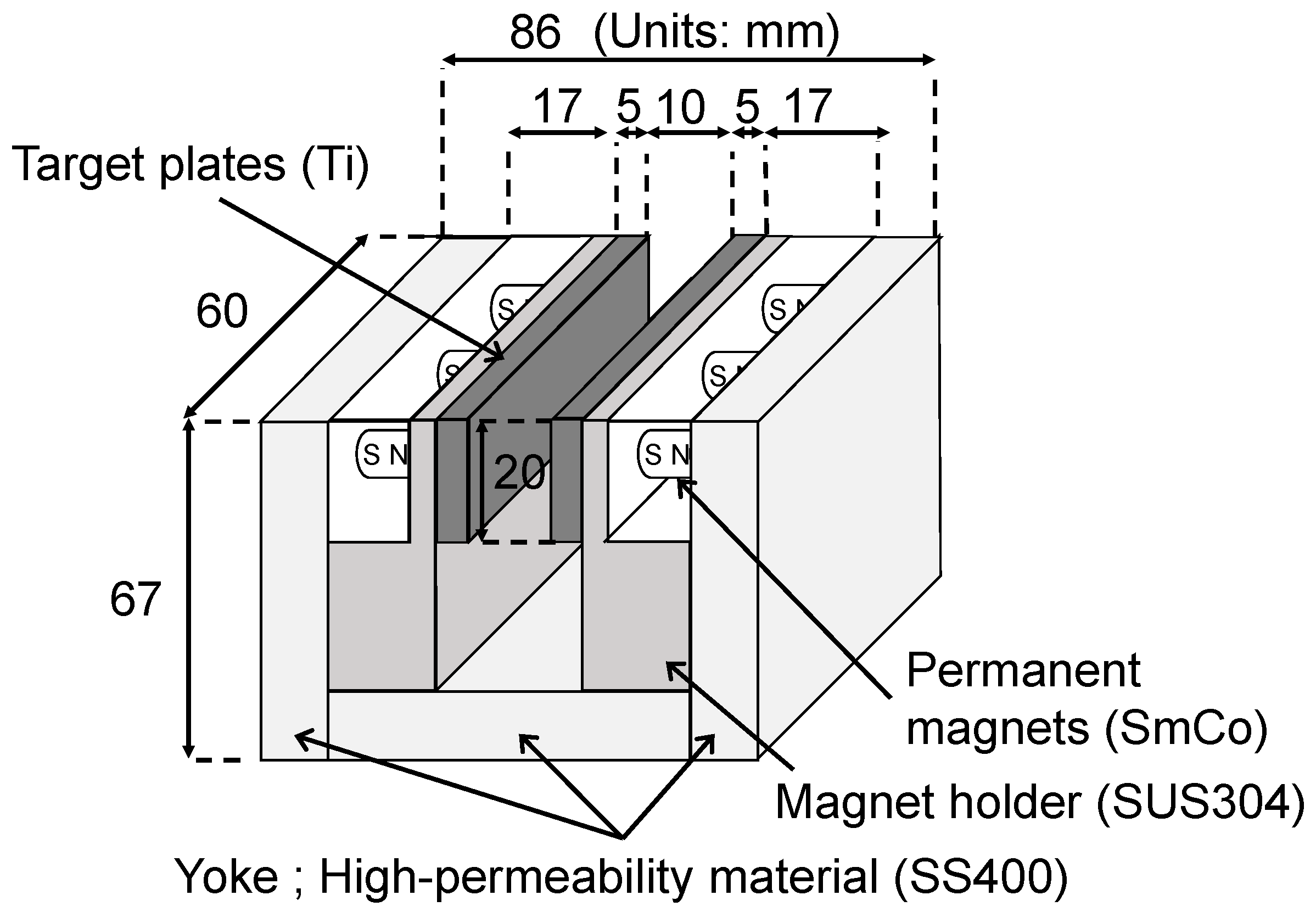
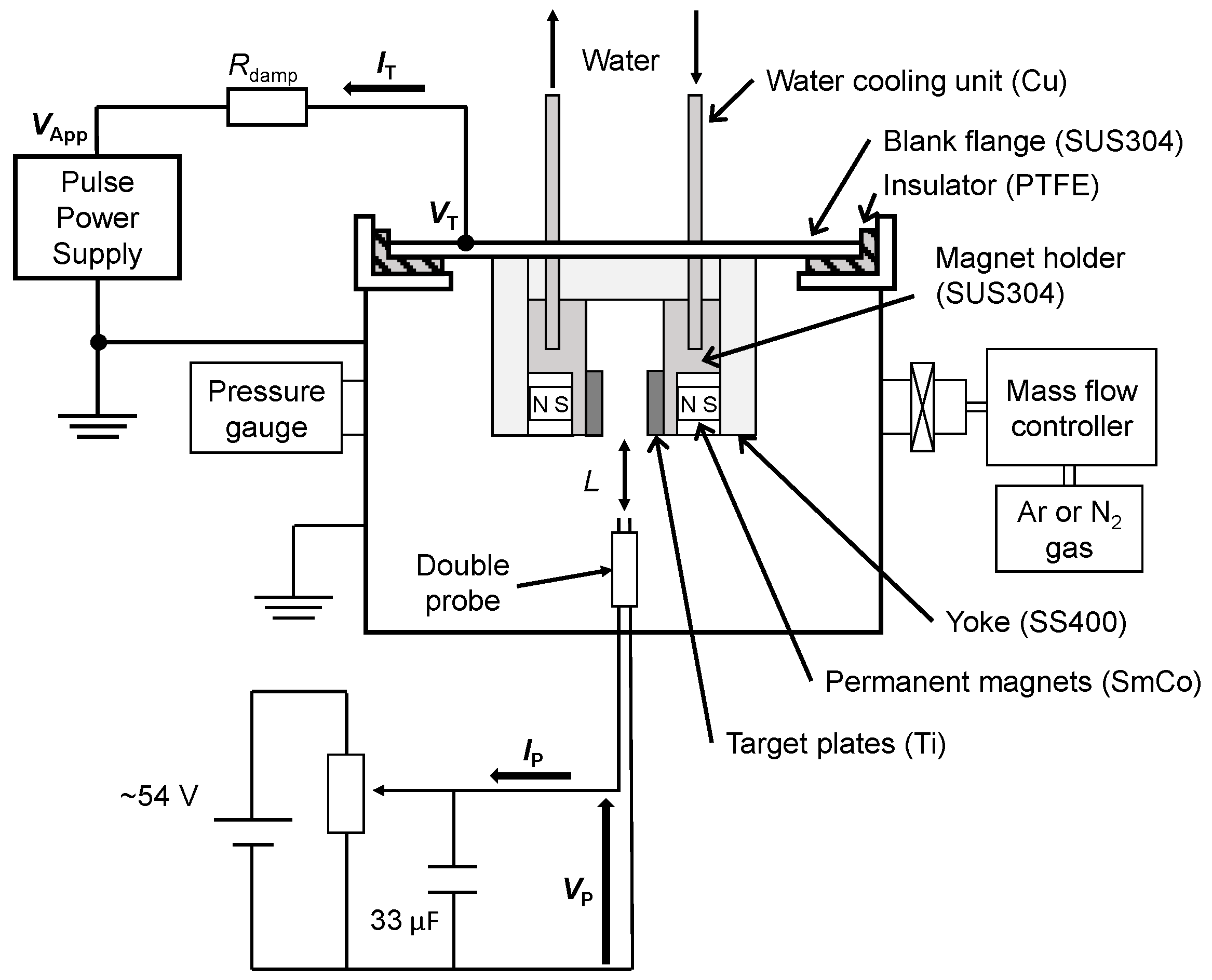
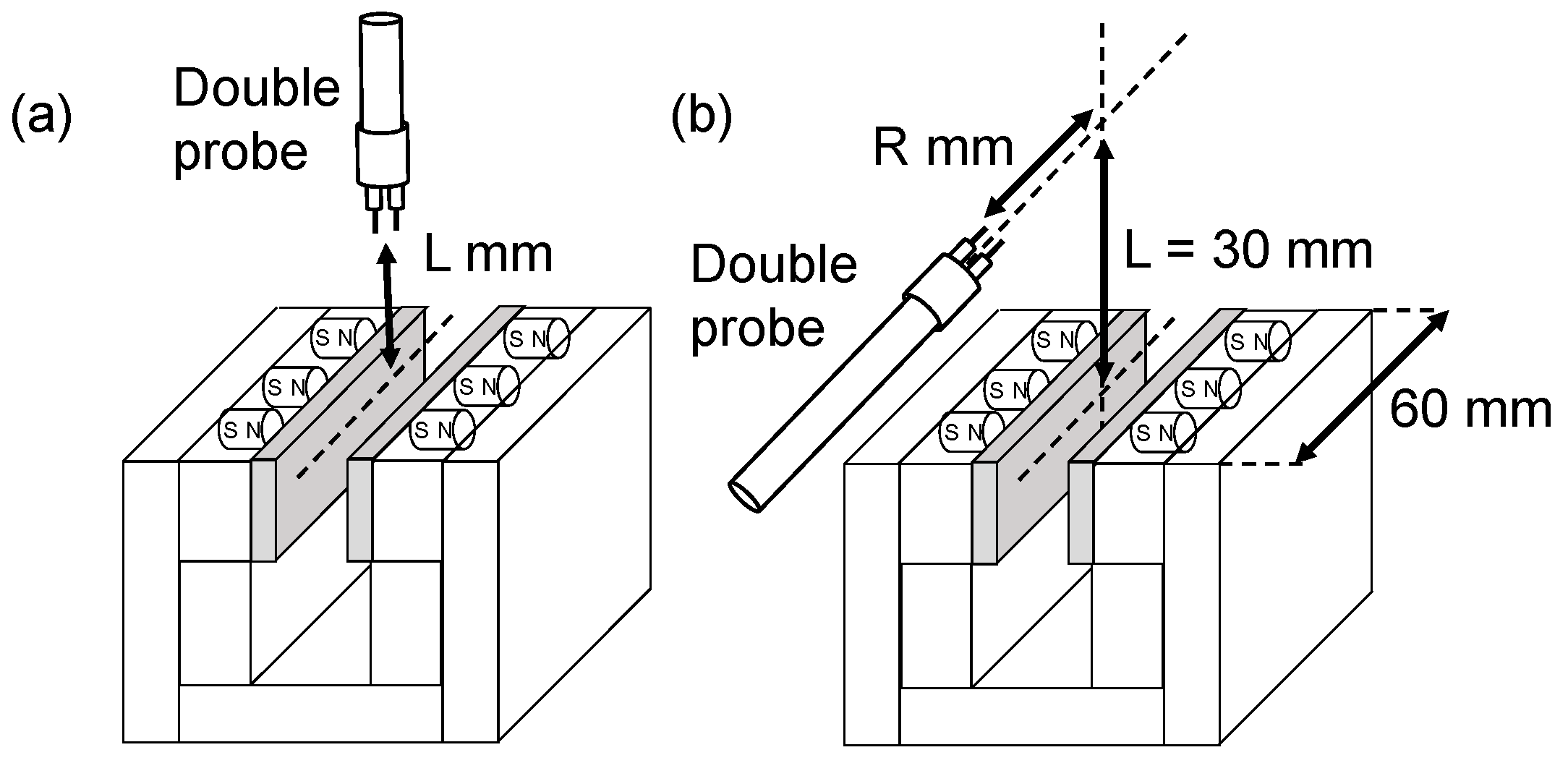




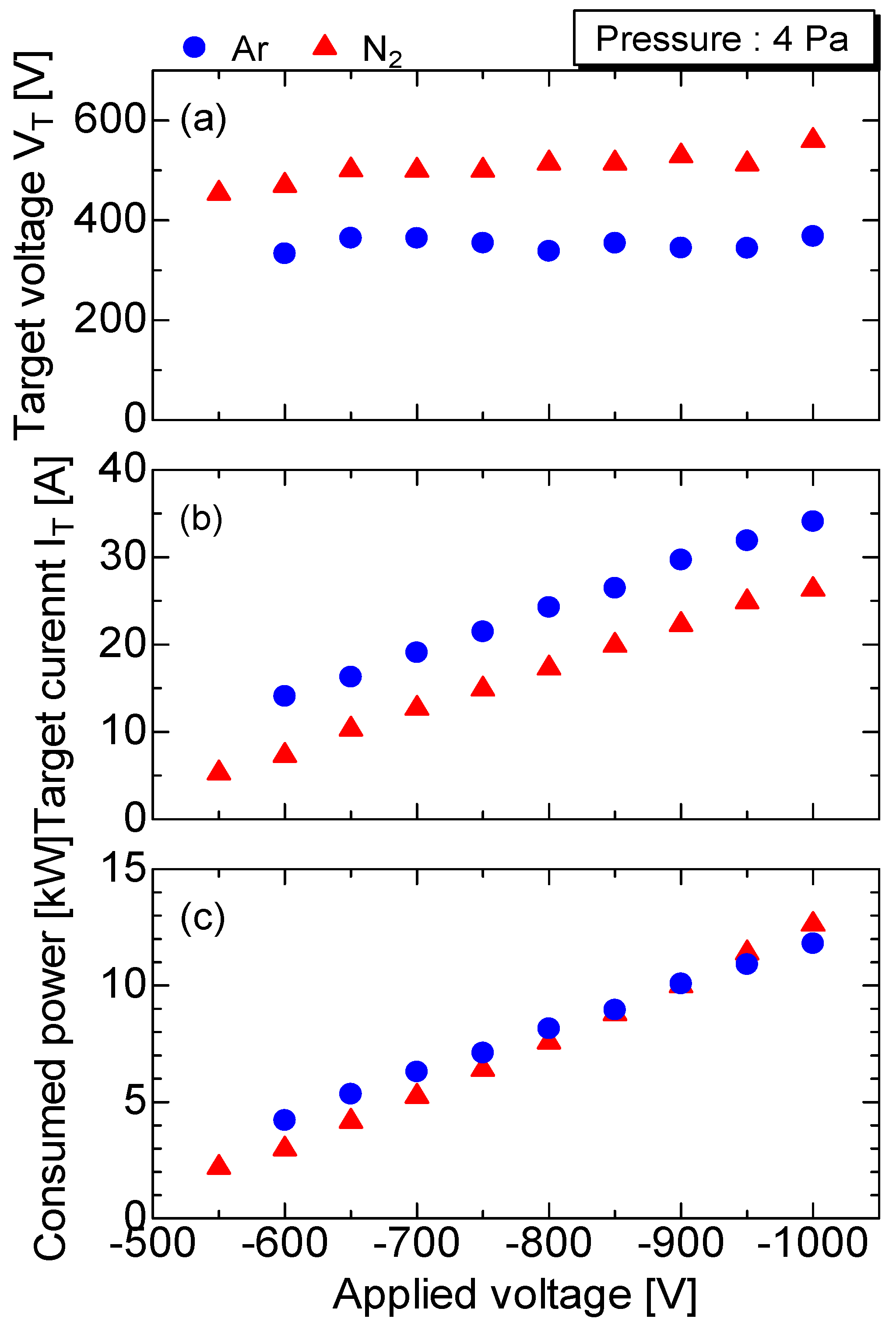

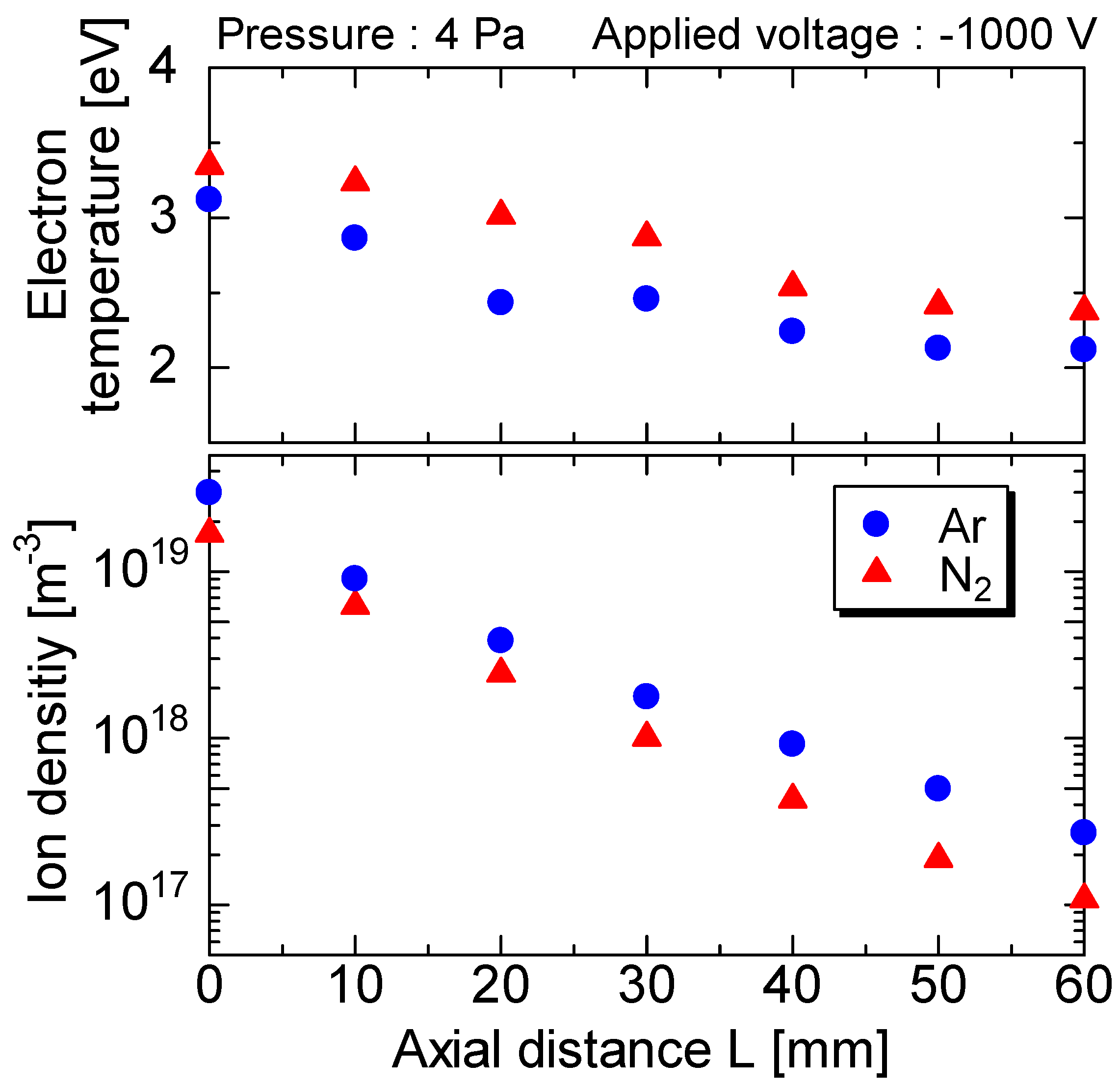

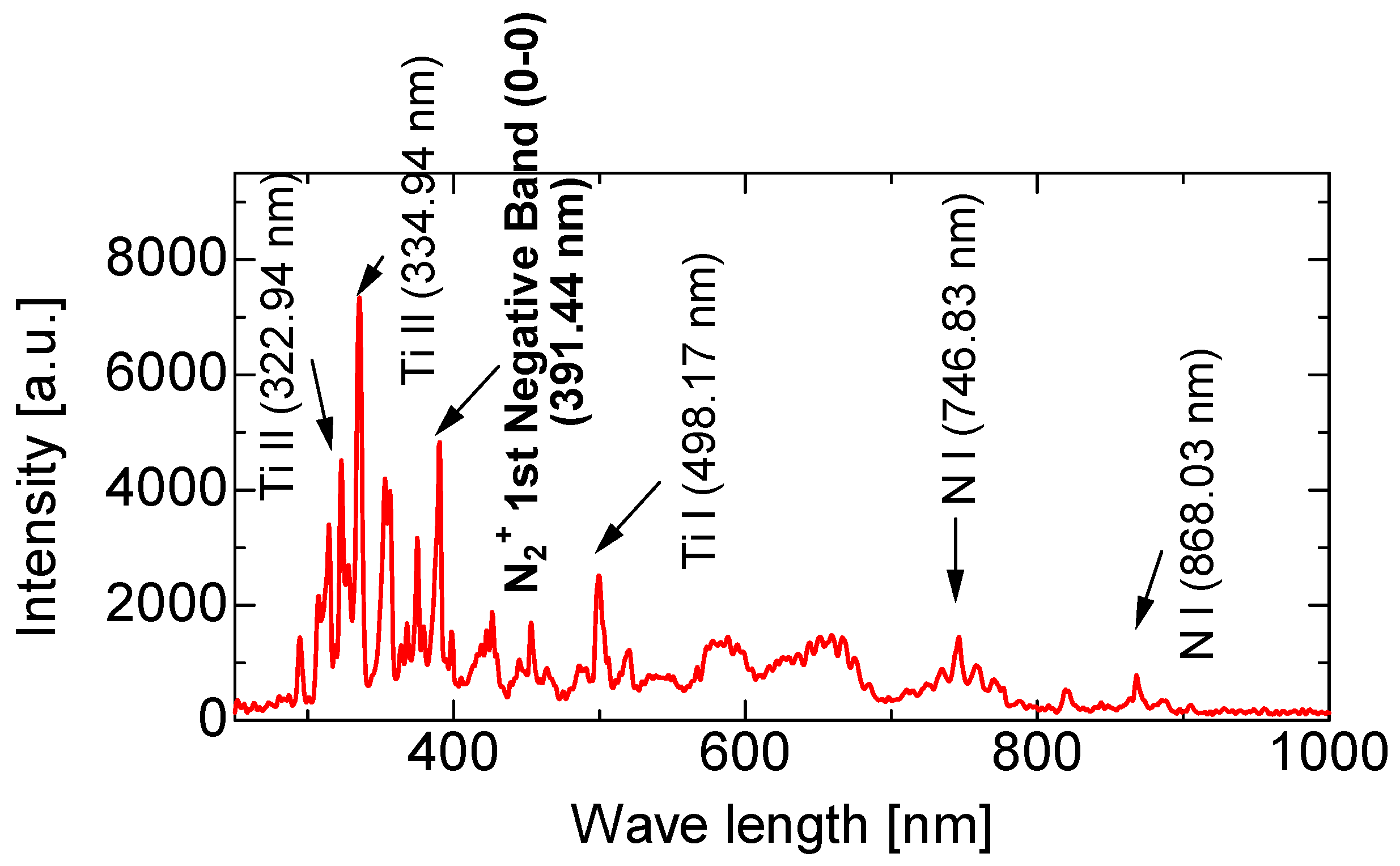

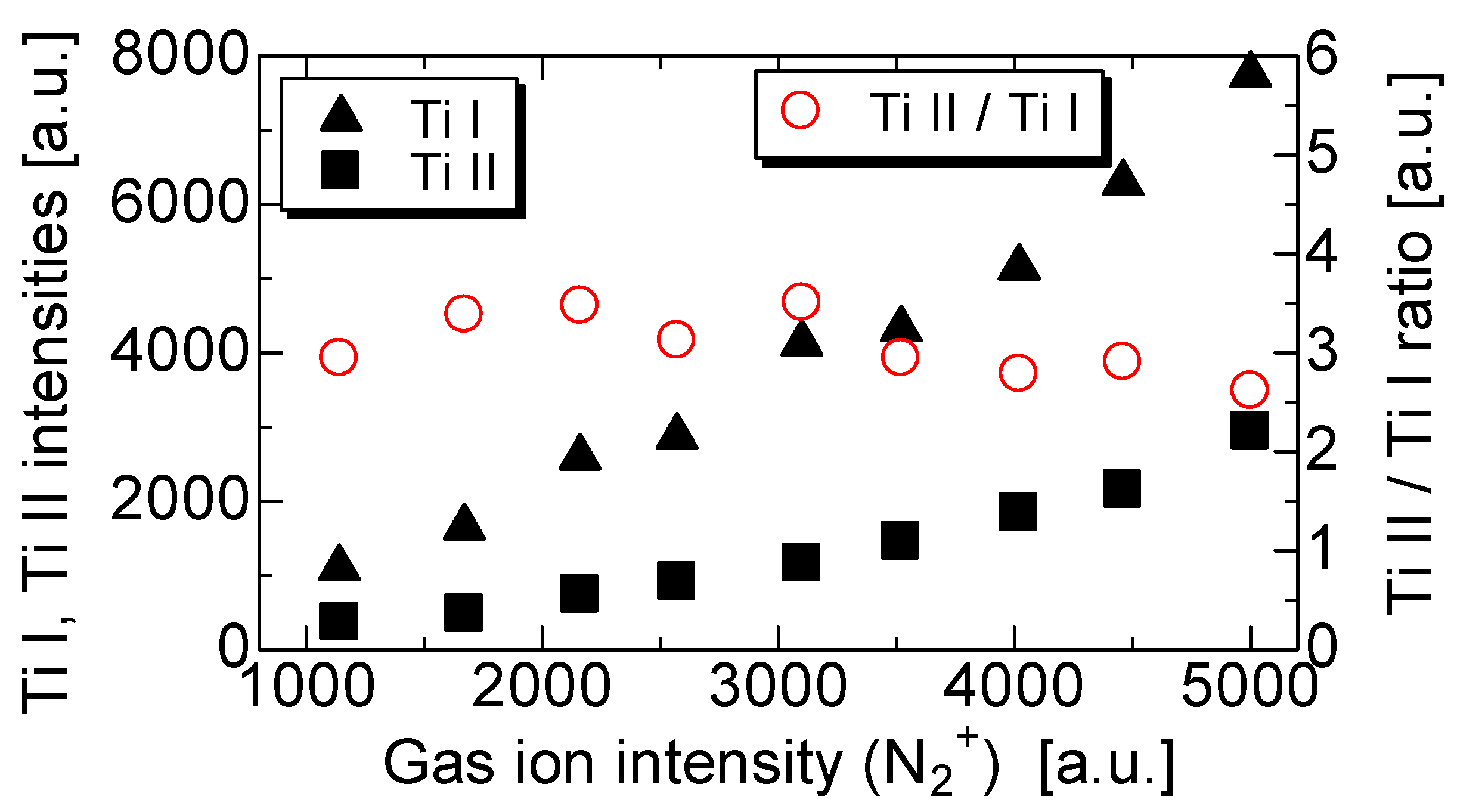
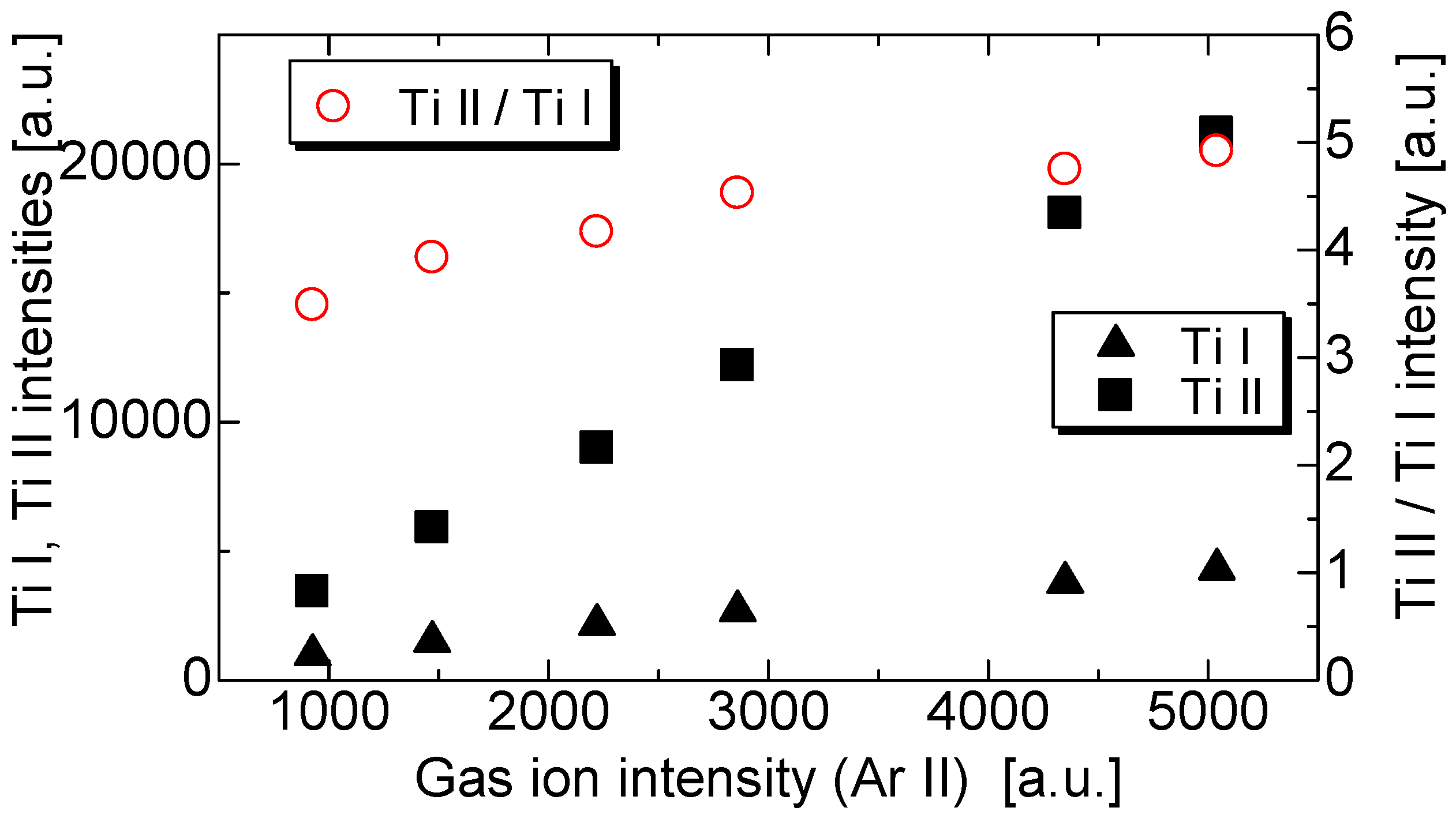
Disclaimer/Publisher’s Note: The statements, opinions and data contained in all publications are solely those of the individual author(s) and contributor(s) and not of MDPI and/or the editor(s). MDPI and/or the editor(s) disclaim responsibility for any injury to people or property resulting from any ideas, methods, instructions or products referred to in the content. |
© 2024 by the authors. Licensee MDPI, Basel, Switzerland. This article is an open access article distributed under the terms and conditions of the Creative Commons Attribution (CC BY) license (https://creativecommons.org/licenses/by/4.0/).
Share and Cite
Sato, T.; Igarashi, S.; Takahashi, K.; Mukaigawa, S.; Takaki, K. Production of High-Power Nitrogen Sputtering Plasma for TiN Film Preparation. Processes 2024, 12, 1314. https://doi.org/10.3390/pr12071314
Sato T, Igarashi S, Takahashi K, Mukaigawa S, Takaki K. Production of High-Power Nitrogen Sputtering Plasma for TiN Film Preparation. Processes. 2024; 12(7):1314. https://doi.org/10.3390/pr12071314
Chicago/Turabian StyleSato, Taishin, Sawato Igarashi, Katsuyuki Takahashi, Seiji Mukaigawa, and Koichi Takaki. 2024. "Production of High-Power Nitrogen Sputtering Plasma for TiN Film Preparation" Processes 12, no. 7: 1314. https://doi.org/10.3390/pr12071314






